Vietnam-China:
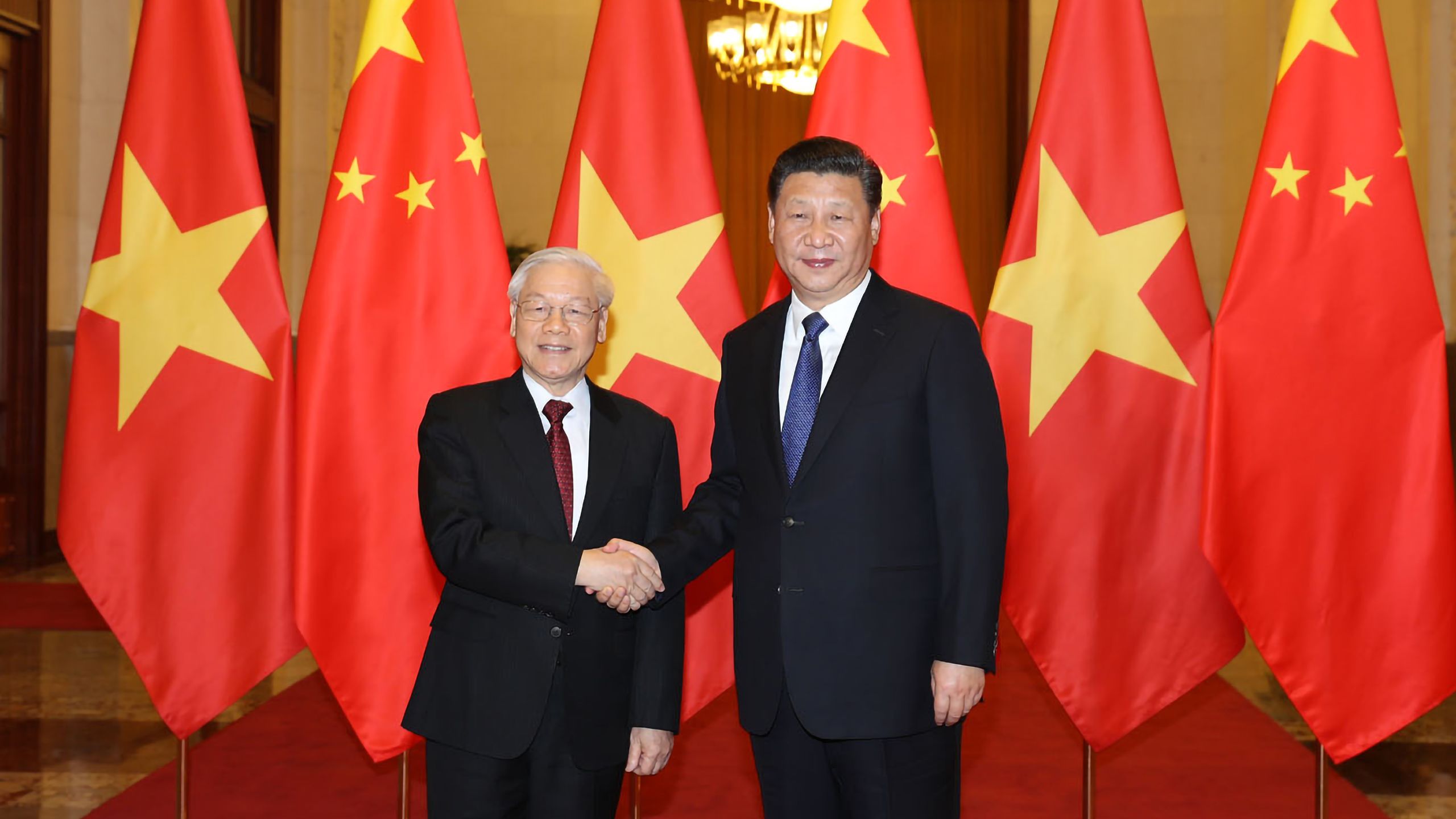
January 18, 1950, went down in the history of Vietnam-China relations as an important milestone. Not long after its establishment, the People’s Republic of China was the first country in the world to establish diplomatic relations with the Democratic Republic of Vietnam, now the Socialist Republic of Vietnam. The two Parties, the two countries and the two peoples have stood shoulder to shoulder, giving each other great and valuable support and assistance, contributing to the success of the revolutionary cause of national liberation and socialist construction in each country.
Over the past 70 years, Vietnam-China relations have seen ups and downs, but friendship and cooperation remain the main trends. The friendship cultivated by President Ho Chi Minh and President Mao Zedong and generations of leaders of the two countries, has become a valuable common asset of the two nations, contributing to maintaining the trend of stable development of the traditional friendship between Vietnam and China, as well as bringing practical benefits to the two peoples.
GREAT IMPORTANCE IS ATTACHED TO THE POLITICAL RELATIONSHIP
What is the “16 Words” Guideline and the spirit of “Four Good” in Vietnam-China relations?
Vietnam-China relations have developed deeply in all fields, from politics and economy to culture, security and defence. High-level exchanges and meetings are maintained regularly in many flexible forms. Through the visits and meetings, the senior leaders of the two Parties and the two countries have reached many important common perceptions, contributing to consolidating and enhancing political trust and promoting comprehensive cooperation in various fields, which is the fundamental and long-term strategic orientation for the healthy and stable development of Vietnam-China relations.
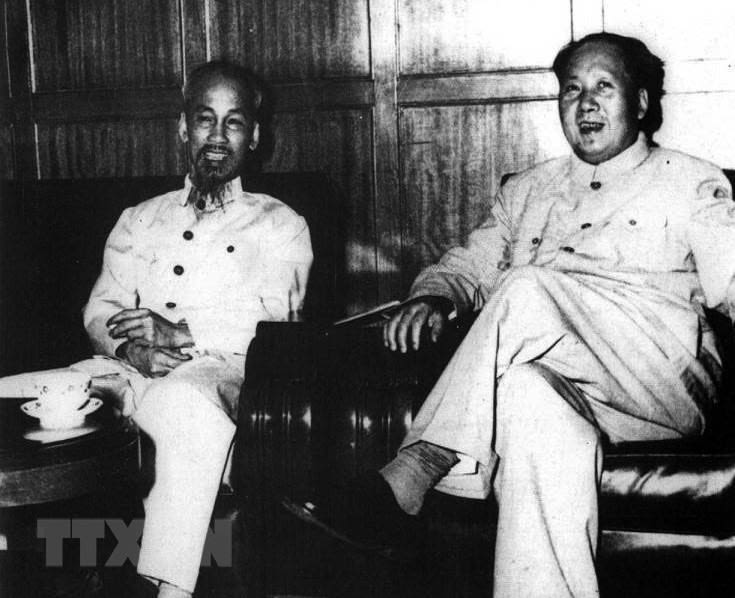
President Mao Zedong receives President Ho Chi Minh in Beijing, China, on June 25, 1955. (Photo: VNA)
President Mao Zedong receives President Ho Chi Minh in Beijing, China, on June 25, 1955. (Photo: VNA)
During the visit to China by General Secretary Le Kha Phieu in 1999, senior leaders of the two Parties and the two countries identified the 16-word guidelines to promote the two country’s relations in the 21st century, as “friendly neighbourliness, comprehensive cooperation, long-term stability and future-oriented thinking.”
In 2000, President Tran Duc Luong visited China, and the two sides signed a Joint Statement on comprehensive cooperation in the new century. After that, the two sides agreed to turn the two countries into “good neighbours, good friends, good comrades, good partners" (the spirit of “four good”).
In particular, during the visit to China by General Secretary Nong Duc Manh in May 2008, the two sides agreed to establish the Vietnam-China relationship as a Comprehensive strategic cooperative partnership under the “16 Words” Guideline and the spirit of “Four Good”.
How is the attachment and trust in Vietnam-China political relations in recent years?
Cooperation between the two Parties has been promoted, making an important contribution to the building of trust between the two countries. The two sides have also maintained high-level contacts and established cooperation and exchange mechanisms between Party committees at the central level. The complicated COVID-19 pandemic restricted travel conditions, but the two sides have maintained regular communication flexibly and effectively.
In the past three years, the General Secretaries of the two Parties have held phone calls four times (January 2020, September 2020, February 2021, and September 2021). Every year, the two General Secretaries send gifts and congratulatory messages on the occasion of the two country’s traditional New Year and each other’s birthdays, as well as on major holidays of the two countries. President Nguyen Xuan Phuc had a phone call with Chinese President Xi Jinping in May 2021, while the Prime Ministers of the two sides talked by phone three times in June 2021, January 1, 2022, and September 2022. The National Assembly Chairman held an online talk with the Chairman of the National People’s Congress of China in June 2021. These activities have contributed to strategic orientation, creating motivation and political guarantee for the healthy and stable development of bilateral relations.

Party General Secretary and President of China Xi Jinping and Party General Secretary Nguyen Phu Trong visit the exhibition on results of the theoretical workshops between the Communist Party of China and the Communist Party of Vietnam, on the occasion of the Vietnamese Party leader’s official visit to China from April 7-10, 2015. (Photo: VNA)
Party General Secretary and President of China Xi Jinping and Party General Secretary Nguyen Phu Trong visit the exhibition on results of the theoretical workshops between the Communist Party of China and the Communist Party of Vietnam, on the occasion of the Vietnamese Party leader’s official visit to China from April 7-10, 2015. (Photo: VNA)
At important political events of the two Parties, especially the 13th National Congress of the Communist Party of Vietnam and the 100th anniversary of the Communist Party of China, both sides held special forms of congratulations, showing high respect for Vietnam-China relations. Leaders of Party committees at the central level have also maintained regular exchanges and contacts in various flexible forms. The two sides have effectively implemented the two-Party cooperation plan in the 2016-2020 period, the personnel training cooperation plan between the two Parties in the 2016-2020 period, and the cooperation agreement on training senior officials between the two Parties in the 2017-2020 period. In April 2022, the two sides signed a cooperation plan between two Parties for the 2021-2025 period and a plan for personal training between the two Parties for the 2021-2025 period.
The two sides regularly coordinate to organise theoretical workshops between the two Parties, to exchange experiences on Party building and national management. The two sides have organised 16 theoretical workshops.
Cooperation on the State channel continues to be effectively and substantively promoted. Exchanges and cooperation between the National Assembly of Vietnam and the National People's Congress of China, between the Vietnam Fatherland Front and the Chinese People’s Political Consultative Conference, and between ministries and sectors of diplomacy, defence, and public security have been continuously enhanced. The two sides established a Steering Committee for Vietnam - China bilateral cooperation in November 2006, which held 14 meetings with many practical results. The two sides overcame difficulties caused by the pandemic to successfully organise the recent two meetings in-person form, in Hanoi in September 2021 and Nanning in July 2022.
Cooperation at multilateral forums continues to be strengthened. China thanks and appreciates Vietnam’s support for China at the United Nations, hoping that Vietnam will further strengthen cooperation within the framework of the Mekong – Lancang Cooperation.
What progress has been made in border and territorial cooperation between Vietnam and China?
Implementing the agreements and common perceptions of the two countries’ senior leaders, the existing problems in the relations between the two countries have been gradually resolved. The two countries signed the Land Border Treaty in 1999 and the Agreement on the Delimitation of the Tonkin Gulf and the Vietnam-China Fisheries Cooperation Agreement in 2000, while completing all land border demarcation and marker planting in 2008 and signed three documents on land border management in 2009. These are important events of historical significance, creating the premise to build the Vietnam-China border into a border of peace, stability and development, contributing to strengthening the friendship and cooperation between the two countries.
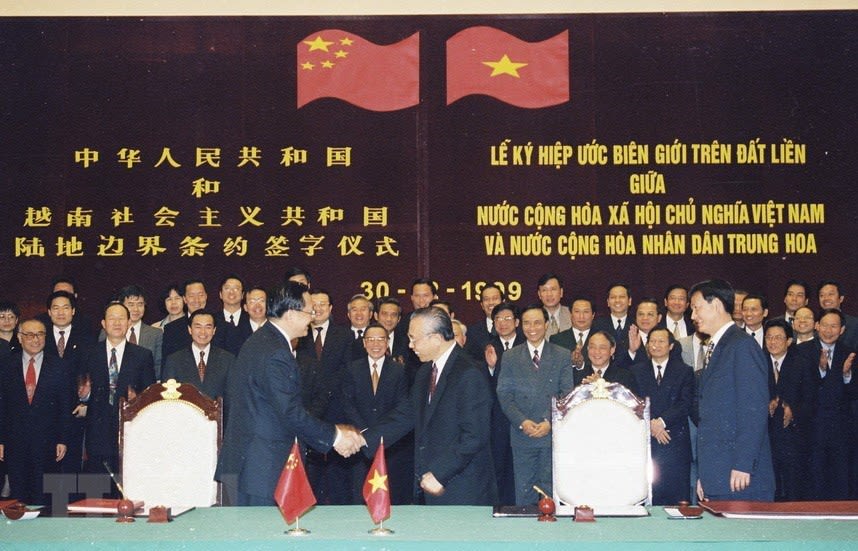
On December 30, 1999, in Hanoi, Vietnamese Deputy Prime Minister cum Foreign Minister Nguyen Manh Cam and Chinese Foreign Minister Tang Jiaxuan sign an agreement on the land border between the two countries. (Photo: VNA)
On December 30, 1999, in Hanoi, Vietnamese Deputy Prime Minister cum Foreign Minister Nguyen Manh Cam and Chinese Foreign Minister Tang Jiaxuan sign an agreement on the land border between the two countries. (Photo: VNA)
Cooperation between Vietnamese and Chinese localities, especially those sharing the border such as Guangxi and Yunnan, is busy and has recorded many substantive achievements.
Exchange and cooperation programmes between the two countries’ localities are frequently held, such as the spring meetings between the Party Secretaries of Vietnam’s Quang Ninh, Lang Son, Cao Bang, Ha Giang and the Party Secretary of China’s Guangxi, in addition to the joint working committee between four Vietnamese provinces and Guangxi, the joint working group between Vietnam’s Ha Giang, Lao Cai, Lai Chau, Dien Bien and China’s Yunnan, and economic corridor cooperation between Vietnam’s Lao Cai, Hanoi, Hai Phong, Quang Ninh and China’s Yunnan.
The two sides have discussed in depth, the measures to enhance mutual understanding and trust, promote substantive cooperation in all fields, address the difficulties and obstacles during the process of cooperation, together build a border of peace, stability and friendship, helping to develop the Vietnam-China comprehensive strategic cooperative partnership stably and healthily.
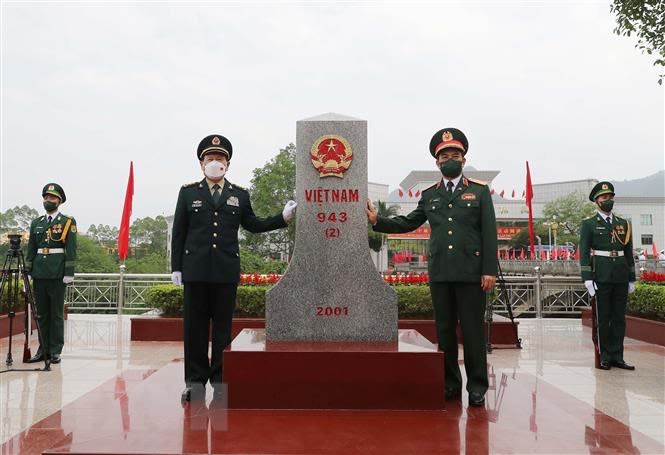
Vietnamese Defence Minister Phan Van Giang and his Chinese counterpart Wei Fenghe stand by a border marker at the Ta Lung border crossing. (Photo: VNA)
Vietnamese Defence Minister Phan Van Giang and his Chinese counterpart Wei Fenghe stand by a border marker at the Ta Lung border crossing. (Photo: VNA)
The situation in the East Sea/South China Sea has not witnessed any serious incidents but remains complicated. The high-ranking leaders of the two Parties and countries have reached many important common perceptions on dispute control and the maintenance of peace and stability in the East Sea. The two sides signed an agreement on the basic principles guiding the settlement of sea-related issues in 2011; have established and regularly maintained the Government-level negotiation mechanism on border and territory issues, the meetings between the two countries’ deputy foreign ministers and three negotiation mechanisms, namely the working group on the waters beyond the mouth of the Gulf of Tonkin, the working group on cooperation in less sensitive maritime issues, and the working group on maritime cooperation for common development.
Valuable lessons during the negotiations on the settlement of land border issues and delimitation in the Gulf of Tonkin along with the agreement on the basic principles guiding the settlement of sea-related issues and the common perceptions reached between the two countries’ high-ranking leaders lay the groundwork and build trust for the two sides to continue negotiating and seek measures to gradually address the East Sea issue peacefully on the basis of the friendly relationship between the two countries, the respect for the legitimate rights and interests of each other, in accordance with international law, especially the 1982 United Nations Convention on the Law of the Sea (UNCLOS) and the Declaration on the Conduct of Parties in the East Sea (DOC) signed between ASEAN and China.
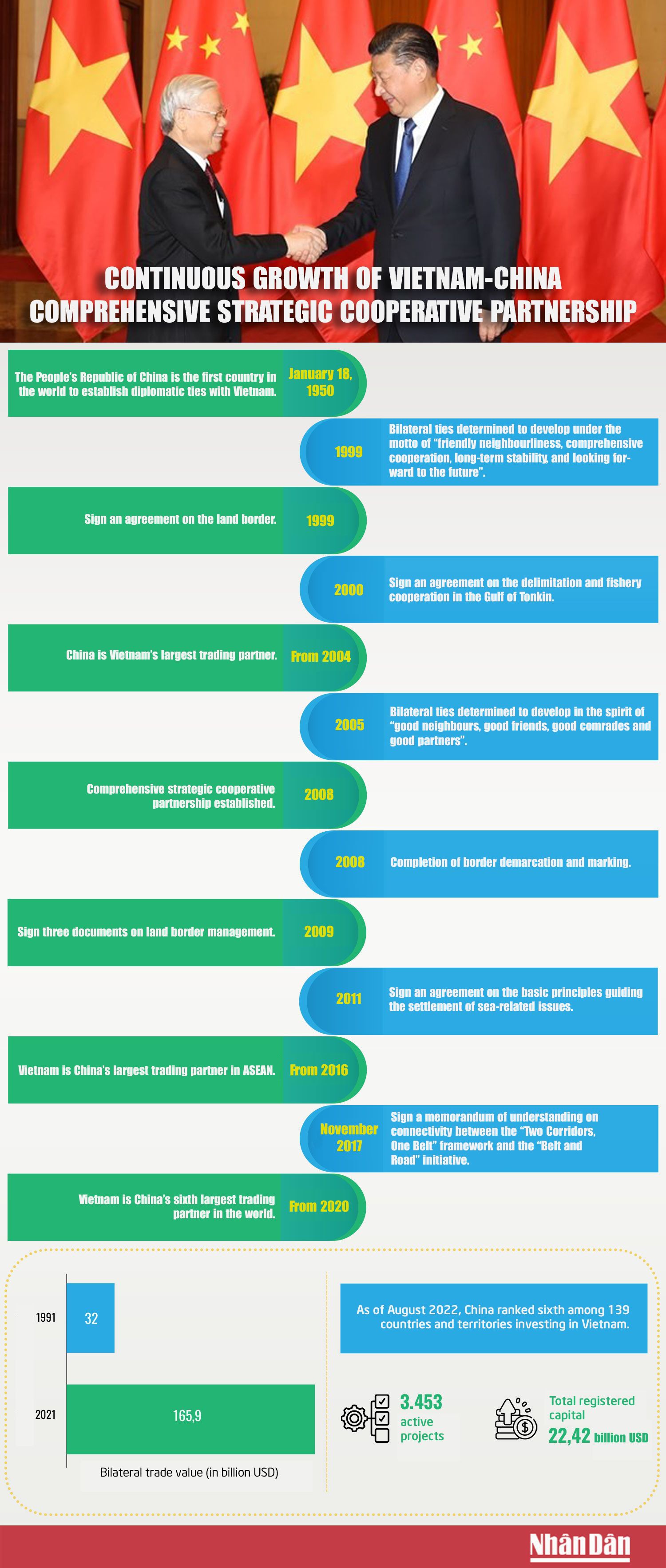
FRIENDLY EXCHANGES BIND THE TWO NATIONS
How was the Vietnam-China Friendship Association formed?
Following the birth of the Democratic Republic of Vietnam in September 1945, the Vietnam-China Fellowship Association was established. It was one of the first friendship organisations with foreign countries in Vietnam and the predecessor of the Vietnam-China Friendship Association.
China was the first country in the world to establish diplomatic relations with Vietnam on January 18, 1950. Less than a month later, on February 11, 1950, the Vietnam-China Friendship Association was established at the Viet Bac revolutionary base, marking an important milestone in the friendly ties between the two countries.
The Vietnam-China Friendship Association is a socio-political organisation that operates within the framework of the laws of the Socialist Republic of Vietnam and following its charter. In terms of organisational structure, the Vietnam-China Friendship Association is organised at central, provincial (or equivalent) and chapter levels.
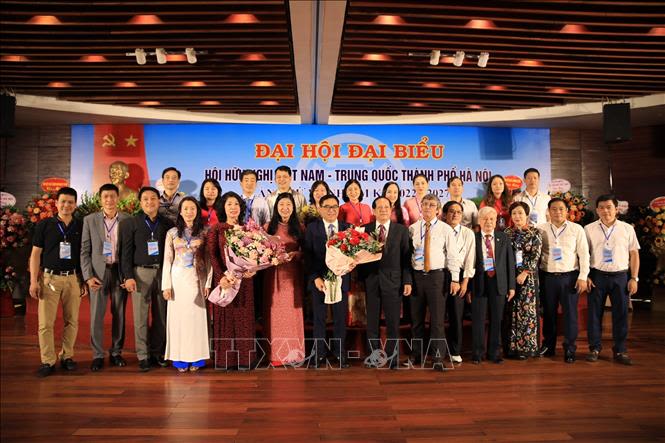
On June 16, 2022, the Vietnam-China Friendship Association, Hanoi chapter, held its 6th Congress for the 2022-2027 tenure. (Photo: VNA)
On June 16, 2022, the Vietnam-China Friendship Association, Hanoi chapter, held its 6th Congress for the 2022-2027 tenure. (Photo: VNA)
The highest governing body of the Association is the National Congress, which is held every five years. The Congress elects the Association’s Central Executive Committee for a five-year tenure. The Central Executive Committee elects a Standing Committee consisting of the Chairman, Vice-Chairmen, General Secretary and several members. The Association's Secretariat is appointed by the Standing Committee and is responsible for handling the daily affairs of the Association. In addition to the Secretariat, several other specialised committees assist the Standing Committee.
Politburo member, Secretary of the Party Central Committee, Chairman of the Central Theoretical Council and Director of Ho Chi Minh National Academy of Politics Nguyen Xuan Thang, is currently the Chairman of the Vietnam-China Friendship Association.
The main task of the Vietnam-China Friendship Association is to provide Vietnamese people with information about the history, culture, life and achievements, during the renewal and opening-up process of Chinese people, while introducing Chinese people to the history, culture, life and achievements during the renewal cause of Vietnamese people.
The Vietnam-China Friendship Association plays a role as a ‘bridge’ for the cooperation in economy and science-technology, as well as cultural exchanges between the two peoples. The Association also encourage and help agencies, as well as cultural, scientific, physical training and sports organisations and businesses from the two countries, to establish friendly and cooperative relations with each other. The Association has also regularly held many people-to-people exchanges, meetings, film screenings, concerts and art performances, that promoted the image of China and celebrated the major holidays of Chinese people.
What were the outstanding people-to-people exchange activities that have contributed to enhancing mutual understanding and trust between Vietnam and China?
The two countries have organised many large-scale people-to-people friendship activities such as the Vietnam-China Border People's Festival, the Vietnam-China People's Forum, and the Friendship Exchanges between the Vietnam Fatherland Front and the National Committee of the Chinese People's Political Consultative Conference. The activities have contributed to consolidating a solid friendship foundation for Vietnam-China relations, to continue to develop healthily and stably.
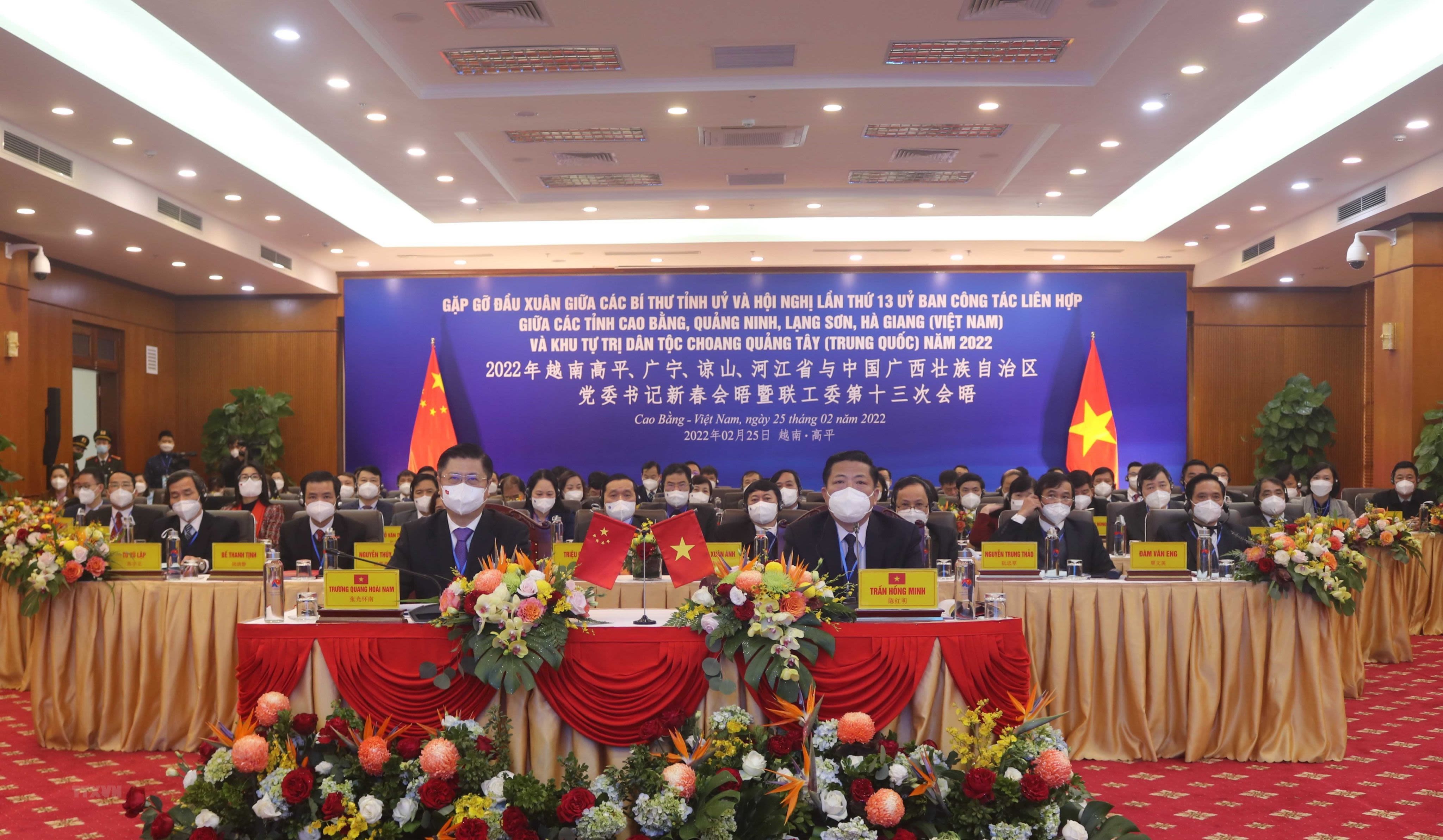
The online spring meeting between Secretaries of Provincial Party Committees of Cao Bang, Lang Son, Quang Ninh and Ha Giang and Guangxi Zhuang Autonomous Region (China) at Cao Bang point. (Photo: VNA)
The online spring meeting between Secretaries of Provincial Party Committees of Cao Bang, Lang Son, Quang Ninh and Ha Giang and Guangxi Zhuang Autonomous Region (China) at Cao Bang point. (Photo: VNA)
On the occasion of major holidays of Vietnam and China and important anniversaries of the two country’s relations, such as the establishment of diplomatic relations, and within the framework of the official visits made by Chinese senior leaders to Vietnam and Vietnamese high-ranking leaders to China, the Vietnam-China Friendship Association organised many intimate meetings. The activities drew the participation of representatives from Vietnamese ministries, departments, agencies, friendship organisations and people who had studied and worked in China, as well as the ambassadors, officials and employees of the Chinese Embassy and Industry and Trade Association in Vietnam and representatives from the Chinese central press agencies in Hanoi. These are opportunities for the delegates to foster intimacy and understanding, discuss the cooperation capabilities and orientations, helping friendship exchanges be carried out effectively.
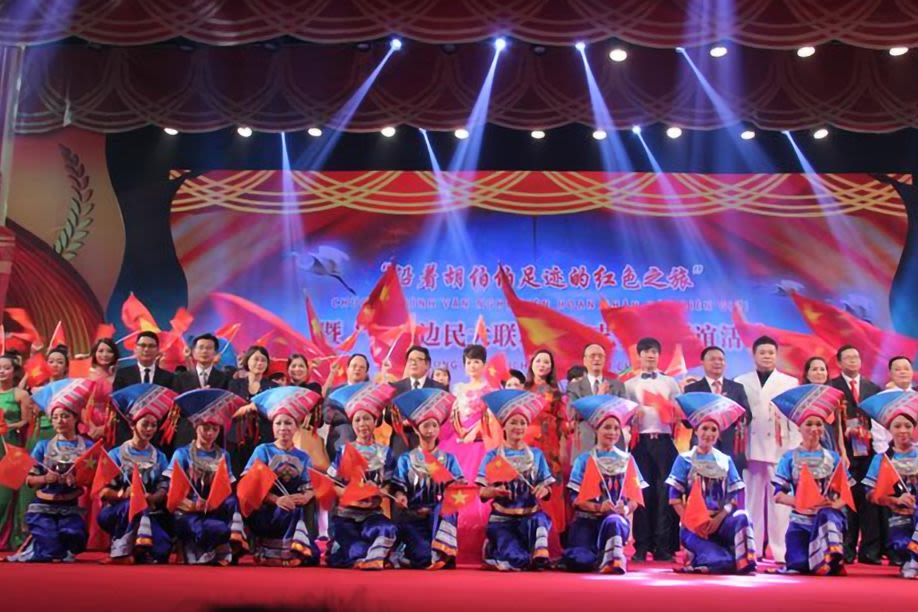
An art programme was held to celebrate the “Red tourism - Following in Uncle Ho's footsteps” activity and the Vietnam - China border people's festival 2015. (Photo: VUFO)
An art programme was held to celebrate the “Red tourism - Following in Uncle Ho's footsteps” activity and the Vietnam - China border people's festival 2015. (Photo: VUFO)
To widely introduce and propagate to the people of the two countries their historical friendship, as well as the beauty and development of each nation in the renewal period, the Vietnam-China Friendship Association organised photo exhibitions, such as those highlighting President Ho Chi Minh’s interest in Vietnam-China relations; achievements during the renewal and international integration process of Vietnam and the opening-up and reform of China. To share experiences and learn from each other, conferences and seminars were held to discuss issues related to promoting friendly cooperation and people-to-people exchanges among the provinces and cities of the two nations.
People-to-people exchanges, especially between the young generations from the two countries, have been more and more practical, contributing to enhancing mutual understanding and boosting the friendship between the two Parties, the two countries and the two peoples. Up to now, the two sides have organised three Vietnam-China Youth Festivals. In 2010 and 2013, the Chinese side invited 3,000 young Vietnamese to China. In 2016, Vietnam invited 1,000 young Chinese. The two countries have organised 19 Vietnam-China Youth Friendship Meetings (with a scale of 100 people per party) in direct form. In 2021 and 2022, the two sides held virtual exchanges and friendship meetings for youths from the two countries, as well as many youth exchanges and cooperation activities between the localities of the two countries, especially those in border areas.
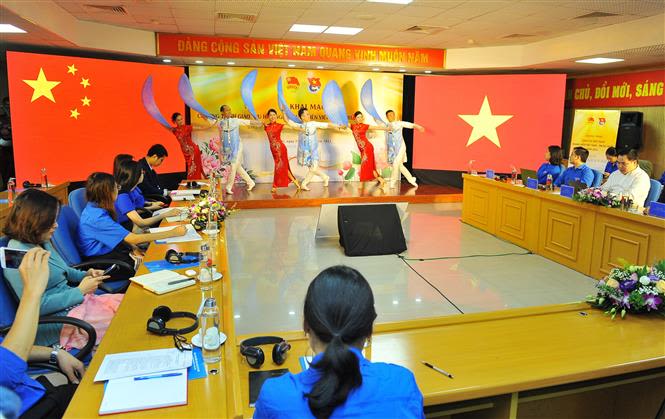
An overview of the Vietnam – China Youth Friendship Exchange in 2021. (Photo: VNA)
An overview of the Vietnam – China Youth Friendship Exchange in 2021. (Photo: VNA)
People in localities, especially in provinces along the shared border between the two countries, have regularly organised practical and friendly exchanges. For example, the Vietnam-China Friendship Association, Cao Bang provincial chapter, has gradually become a pivotal force in the province's people-to-people diplomacy. Cao Bang has two border districts that signed a letter of intent on a district-level friendship twinning with the Chinese side. The locality’s communes and villages signed eight cooperation agreements on friendship and people-to-people exchanges. In addition, 12 residential clusters in border communes and hamlets of the province were twinned with the residential clusters in China.
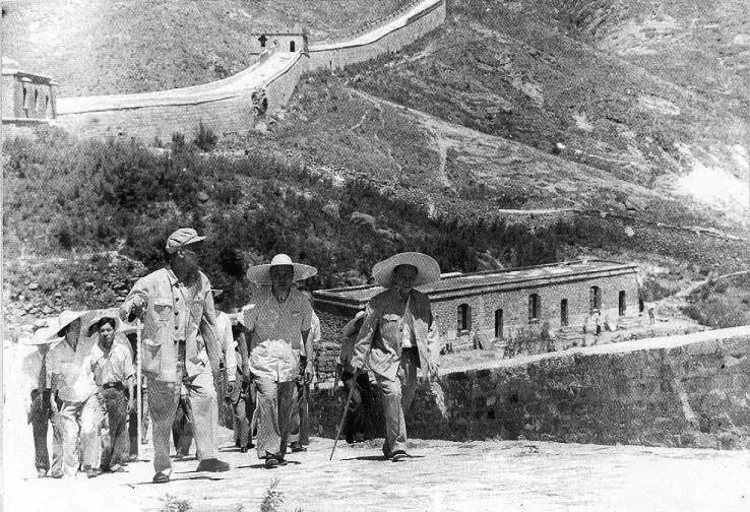
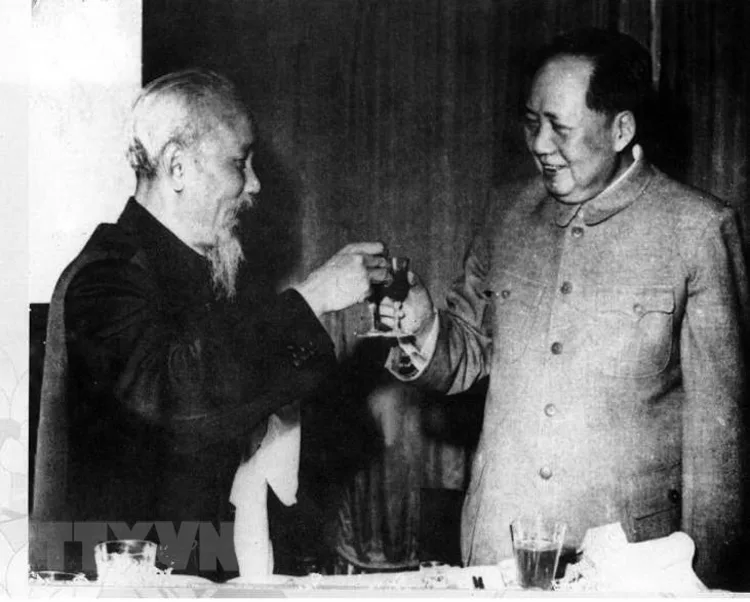
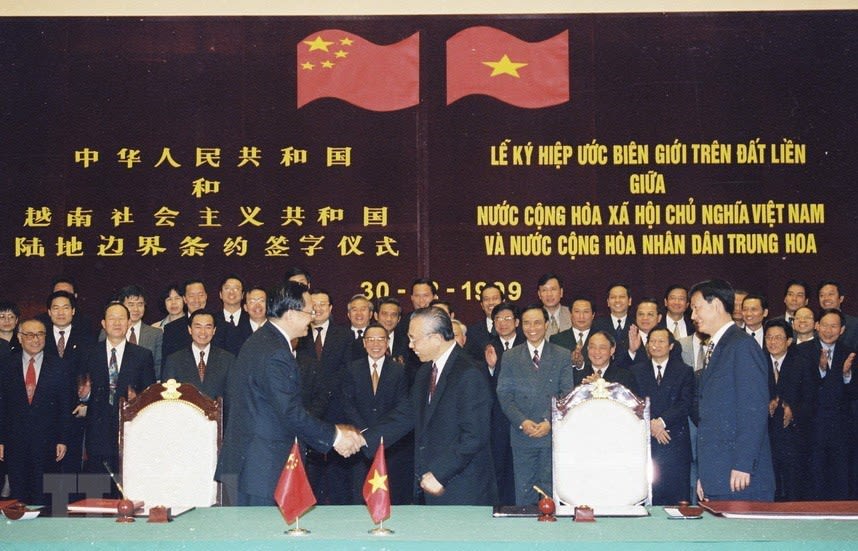
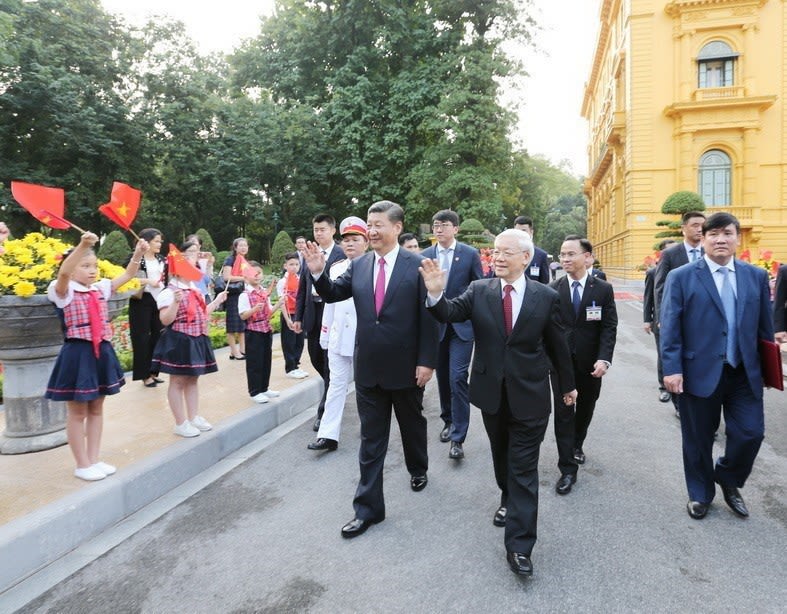

President Ho Chi Minh visits the Great Wall during his visit to China, in July 1955. (Photo: VNA)
President Ho Chi Minh visits the Great Wall during his visit to China, in July 1955. (Photo: VNA)

President Ho Chi Minh and President Mao Zedong cheer for the “forever green and forever sustainable” Vietnam-China friendship, August 1957. (Photo: VNA)
President Ho Chi Minh and President Mao Zedong cheer for the “forever green and forever sustainable” Vietnam-China friendship, August 1957. (Photo: VNA)

On December 30, 1999, in Hanoi, Deputy Prime Minister and Foreign Minister Nguyen Manh Cam and Chinese Foreign Minister Yang Jiechi, sign a land border treaty between the two countries. (Photo: VNA)
On December 30, 1999, in Hanoi, Deputy Prime Minister and Foreign Minister Nguyen Manh Cam and Chinese Foreign Minister Yang Jiechi, sign a land border treaty between the two countries. (Photo: VNA)

General Secretary Nguyen Phu Trong and General Secretary and President of China Xi Jinping, wave to the people and children in Beijing at the welcome ceremony during the State visit made by the General Secretary and President of China to Vietnam from November 12-13, 2017. (Photo: VNA)
General Secretary Nguyen Phu Trong and General Secretary and President of China Xi Jinping, wave to the people and children in Beijing at the welcome ceremony during the State visit made by the General Secretary and President of China to Vietnam from November 12-13, 2017. (Photo: VNA)
ECONOMIC COOPERATION BRINGS PRACTICAL BENEFITS
To what extent is economic and trade cooperation between Vietnam and China?
Vietnam has been continuously the largest trading partner in ASEAN since 2016 and China's sixth largest trading partner in the world since 2020.
The two countries’ senior leaders reached a common understanding on strengthening coordination and jointly promoting cooperation in the fields of economics, trade, production capacity and investment, infrastructure, and finance. The two sides have established and signed many mechanisms, such as: a Working Group on Cooperation on Infrastructure and a Working Group on Monetary Cooperation; an Agreement on extending and supplementing the 5-year development plan for economic and trade cooperation between Vietnam and China for the 2017-2021 period; Amended Border Trade Agreement (2016); and many cooperation Memorandums of Understanding on jointly developing infrastructure cooperation plans and cooperation in production capacity, thereby continuing to create a framework to strengthen and promote bilateral economic-trade cooperation.
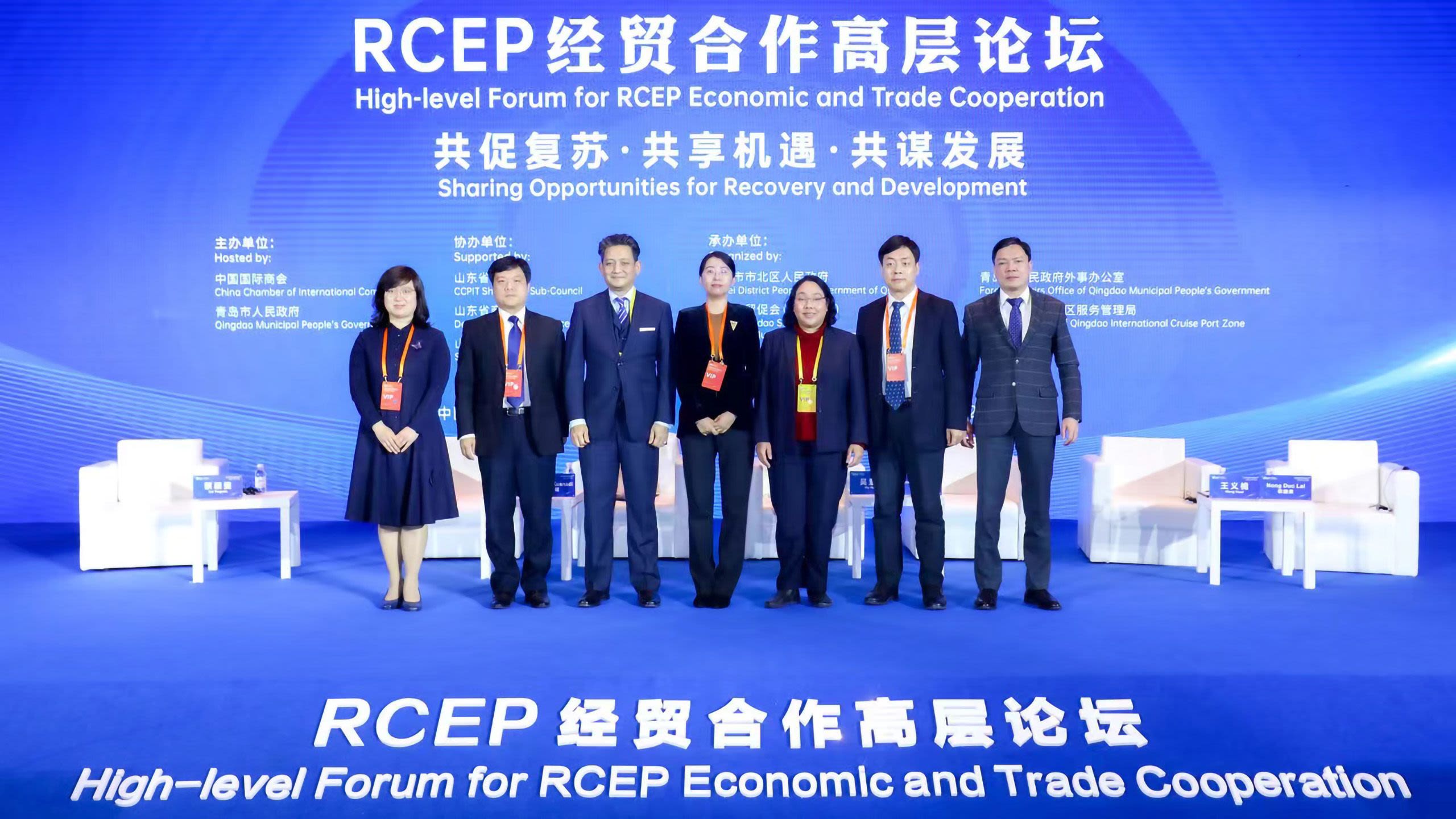
Commercial Counsellor at the Vietnamese Embassy in China Nong Duc Lai (far right) with delegates attending the RCEP Cooperation Summit.
Commercial Counsellor at the Vietnamese Embassy in China Nong Duc Lai (far right) with delegates attending the RCEP Cooperation Summit.
Regarding trade, in the context of the epidemic negatively affecting the trade of most countries around the world, the two-way trade between Vietnam and China maintained an impressive growth momentum. From 32 million USD in 1991, bilateral trade turnover has grown strongly and rapidly to 165.9 billion USD in 2021.
In 2021, the total trade between Vietnam and China reached 165.9 billion USD, an increase of 24.6% compared to 2020 (according to Chinese data, it was 230.2 billion USD, up 19.7% and accounting for one-third of the total trade turnover between China and ASEAN). In the first eight months of 2022, bilateral import and export turnover reached 117.4 billion USD, up 10.8% over the same period in 2021.
Vietnam’s fruit exports to China have made remarkable progress, in which Vietnam’s passion fruit has been piloted for official export to China since July 2022 and fresh durian exported from Vietnam has also been officially approved in September 2022. China has become an important leading market for Vietnam's agriculture, forestry and fishery products, with the value of two-way trade between Vietnam and China in the agricultural sector increasing rapidly and continuously over the years. It is expected to continue to grow strongly in the near future.
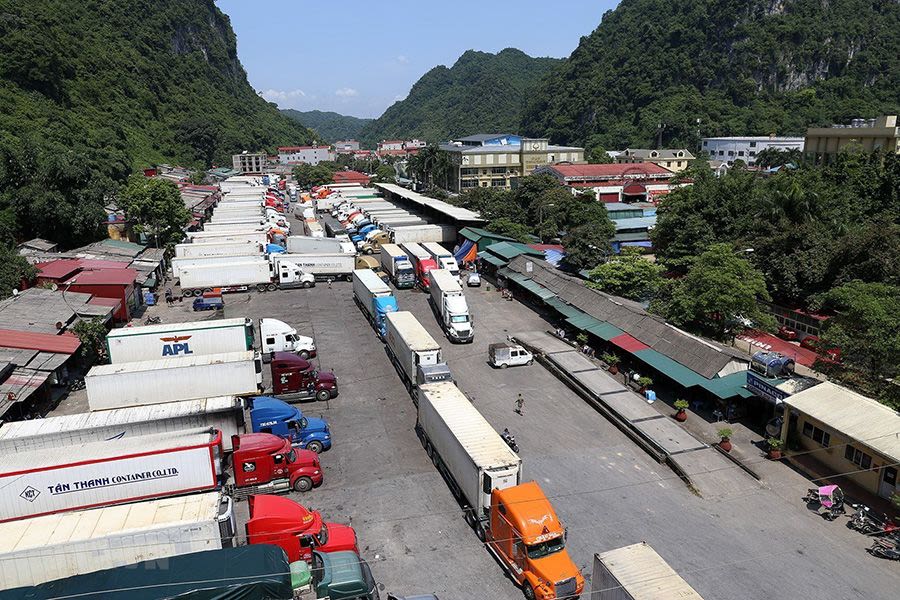
Truck carrying export goods at Tan Thanh border gate. (Photo: VNA)
Truck carrying export goods at Tan Thanh border gate. (Photo: VNA)
Regarding investment, accumulated to August 2022, China ranked 6th out of 139 countries and territories investing FDI in Vietnam with 3,453 valid projects, and total registered capital reaching 22.42 billion USD. Particularly in the first 8 months of 2022, China ranked 4th out of 94 countries and territories investing in Vietnam with 143 projects, with total capital reaching 1.4 billion USD.
Besides the import and export of goods, in what areas do Vietnam and China cooperate?
The two countries strengthen coordination and share experiences in socio-economic development planning; promote economic cooperation, trade and investment; implement projects to improve people’s livelihood and improve people’s quality of life, with a focus more on sustainable and inclusive development. A workshop on the exchange of experiences in poverty reduction between Vietnam and China, organised in December 2021 by the Ministry of Foreign Affairs and some localities of Vietnam in collaboration with the Ministry of Foreign Affairs of China, the Chinese Embassy in Vietnam, and the Yunnan provincial administration, has become an effective bridge for localities of both sides to share experiences and implement cooperative projects on hunger eradication and poverty reduction.
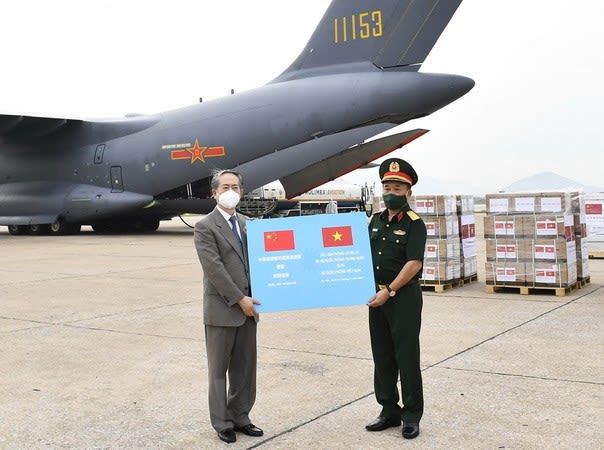
On August 23, 2021, Senior Lieutenant General Hoang Xuan Chien, Deputy Minister of Defence received 200,000 doses of vaccines donated by the Ministry of National Defence of China. (Photo: VNA)
On August 23, 2021, Senior Lieutenant General Hoang Xuan Chien, Deputy Minister of Defence received 200,000 doses of vaccines donated by the Ministry of National Defence of China. (Photo: VNA)
Medical cooperation, especially in the prevention and control of the COVID-19 epidemic, is also a bright spot in the relationship between the two countries. China is one of the countries that provided the most and fastest COVID-19 vaccines to Vietnam; by the end of 2021, China has aided Vietnam with 7.3 million doses and commercially supplied about 45 million doses of vaccine. At the 14th meeting of the Steering Committee for Bilateral Cooperation in July 2022, China announced that it would give Vietnam an additional 10 million doses of vaccines. Chinese localities (Guangxi, Yunnan and Guangdong) also donated a large number of medical supplies to Vietnamese localities. Through the Party channel, China presented Vietnam with a batch of medical supplies worth 1.5 million CNY (about 5.4 billion VND).
Production manager: CHU HONG THANG - PHAM TRUONG SON
Content: SON NINH - DINH TRUONG - VO PHONG
Design: HOANG HA, PHAN ANH
Translation: NDO
Sources: The Party Central Committee’s Commission for External Relations, the Ministry of Foreign Affairs, and the Vietnam Union of Friendship Organisations.